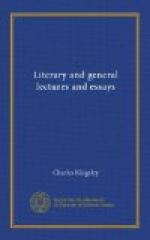For an eclectic, if it mean, anything, means this—one who, in any branch of art or science, refuses to acknowledge Bacon’s great law, “that nature is only conquered by obeying her;” who will not take a full and reverent view of the whole mass of facts with which he has to deal, and from them deducing the fundamental laws of his subject, obey them whithersoever they may lead; but who picks and chooses out of them just so many as may be pleasant to his private taste, and then constructs a partial system which differs from the essential ideas of nature, in proportion to the number of facts which he has determined to discard. And such a course was pursued in the art by the ascetic painters between the time of Giotto and Raphael. Their idea of beauty was a partial and a Manichean one; in their adoration for a fictitious “angelic nature,” made up from all which is negative in humanity, they were prone to despise all by which man is brought in contact with this earth—the beauties of sex, of strength, of activity, of grandeur of form; all, that is, in which Greek art excels: their ideal of beauty was altogether effeminate. They prudishly despised the anatomic study of the human figure, of landscape and chiaroscuro. Spiritual expression with them was everything; but it was only the expression of the passive spiritual faculties of innocence, devotion, meekness, resignation—all good, but not the whole of humanity. Not that they could be quite consistent in their theory. They were forced to paint their very angels as human beings; and a standard of human beauty they had to find somewhere; and they found one, strange to say, exactly like that of the old Pagan statues (wings and all—for the wings of Christian angels are copied exactly from those of Greek Genii), and only differing in that ascetic and emasculate tone, which was peculiar to themselves. Here is a dilemma which the worshippers of high art have slurred over. Where did Angelico de Fiesole get the idea of beauty which dictated his exquisite angels? We shall not, I suppose, agree with those who attribute it to direct inspiration, and speak of it as the reward of the prayer and fasting by which the good monk used to prepare himself for painting. Must we then confess that he borrowed his beauties from the faces of the prettiest nuns with whom he was acquainted? That would be sad naturalism; and sad eclecticism too, considering that he must have seen among his Italian sisters a great many beauties of a very different type from that which he has chosen to copy; though, we suppose, of God’s making equally with that of his favourites. Or did he, in spite of himself, steal a side-glance now and then at some of the unrivalled antique statues of his country, and copy on the sly any feature or proportion in them which was emasculate enough to be worked into his pictures? That, too, is likely enough; nay, it is certain. We are perfectly astonished how any draughtsman, at least




